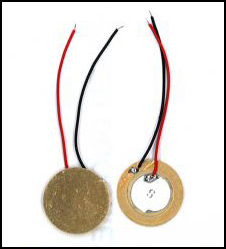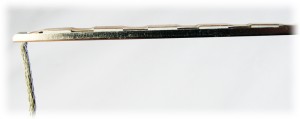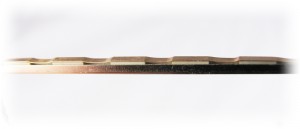 When looking at the use of piezo elements as pickups in acoustic instruments, and specifically in cigar box guitars, there are two main types that get used – disk-style piezos, and rod-style piezos
When looking at the use of piezo elements as pickups in acoustic instruments, and specifically in cigar box guitars, there are two main types that get used – disk-style piezos, and rod-style piezos
While disk piezos are perhaps more prevalent, because they tend to be cheaper and easier to find, many builders feel that the rod-style piezos offer superior sound and tonal quality. This article delves into the differences between disk and rod-style piezos, and takes a close look at how rod piezos are put together.
First, a little bit of piezo basics. Piezoelectric elements, whatever the type, are based around layered ceramic wafers and conductive metal.  The interaction between the ceramic and the metal works in two ways: if outside electrical current is supplied, then the piezo will produce sounds. This property allows them to be used as buzzers and simple speakers. However, if no outside current is supplied and instead the piezo is subjected to changes in pressure (such as by the vibrations of guitar strings), then the interaction of the metal and ceramic actually creates a small amount of electrical current. This current, when wired into a guitar amplifier, is magnified and reproduced on a speaker in the form recognizable to the human ear as being an amplification of the acoustic instrument. So as you can see, for such a simple little device, piezos are really quite versatile and useful.
The interaction between the ceramic and the metal works in two ways: if outside electrical current is supplied, then the piezo will produce sounds. This property allows them to be used as buzzers and simple speakers. However, if no outside current is supplied and instead the piezo is subjected to changes in pressure (such as by the vibrations of guitar strings), then the interaction of the metal and ceramic actually creates a small amount of electrical current. This current, when wired into a guitar amplifier, is magnified and reproduced on a speaker in the form recognizable to the human ear as being an amplification of the acoustic instrument. So as you can see, for such a simple little device, piezos are really quite versatile and useful.
As mentioned above, piezo disks are the most commonly seen type of piezo element. They are used as buzzers and small speakers in a wide range of household products, such as alarm clocks, microwave ovens and more. Really the most basic of piezoelectric elements, piezo disks are just thin, usually round disks of brass or stainless steel, on which is glued a ceramic disk. One lead is soldered to the ceramic, and one to the metal, and the piezo is ready to function. Cigar box guitar builders place these disks inside the cigar box, or build them into the bridge, so that they will pick up as much as possible of the guitar’s vibration for amplification.
Rod piezos, on the other hand, are constructed specifically for use as acoustic instrument pickups. Instead of a round disk, they tend to be long and thin – those made for a standard 6-string acoustic guitar tend to be about 2 ¾” long by about 1/8” wide by about 3/16” high. The main body  of the rod is conductive metal, and onto this metal are glued a number of small ceramic wafer squares, as shown in the photo. Across the top of these wafers runs a thin strip of conductive metal. This strip, and the conductive base under the ceramic wafers, are both connected to the leads that run from the piezo rod (generally a single wire with an insulated positive lead inside a wired mesh ground). The number of the ceramic wafers varies depending on what instrument the rod piezo is meant to be used in. By far the most common setup is to have 6 wafers – one for each string on a standard 6-string acoustic guitar. But other types are also manufactured – such as a shorter four-wafer rod for mandolins.
of the rod is conductive metal, and onto this metal are glued a number of small ceramic wafer squares, as shown in the photo. Across the top of these wafers runs a thin strip of conductive metal. This strip, and the conductive base under the ceramic wafers, are both connected to the leads that run from the piezo rod (generally a single wire with an insulated positive lead inside a wired mesh ground). The number of the ceramic wafers varies depending on what instrument the rod piezo is meant to be used in. By far the most common setup is to have 6 wafers – one for each string on a standard 6-string acoustic guitar. But other types are also manufactured – such as a shorter four-wafer rod for mandolins.
The rod piezo is meant to be mounted directly under the bone (or plastic) saddle on a standard acoustic guitar. This means that it is subjected to as much direct string vibration as possible, which leads to the best possible transmission of the acoustic sounds to the amplifier. Remember that piezos respond to vibration – so the more directly the strings affect it, the better.
 Because the rod piezo has a separate wafer for each string, they tend to reproduce the instrument’s sound much better than a disk piezo, which is unable to be directly affected by every string. This is why many builders prefer rod piezos over disk piezos in their builds – the quality of the sound really is remarkably superior to what you can get out of a disk piezo. In our opinion, with a disk piezo the best you can ever really hope for is “OK” sound. With a rod piezo, you start getting into good sound. Throw in a pre-amp unit, and suddenly your cigar box guitar starts getting into some seriously good tone.
Because the rod piezo has a separate wafer for each string, they tend to reproduce the instrument’s sound much better than a disk piezo, which is unable to be directly affected by every string. This is why many builders prefer rod piezos over disk piezos in their builds – the quality of the sound really is remarkably superior to what you can get out of a disk piezo. In our opinion, with a disk piezo the best you can ever really hope for is “OK” sound. With a rod piezo, you start getting into good sound. Throw in a pre-amp unit, and suddenly your cigar box guitar starts getting into some seriously good tone.
We hope that this article, along with the photos and illustrations, help you gain a better understanding about piezo elements, and especially the difference between disk and rod piezos, and why rod piezos tend to be preferred by savvy builders.

Any wiring diagram showing a standard disk piezo will also work for a rod piezo. The small plug is for plugging it into a pre-amp unit.
How about posting wiring diagrams for rod piezos? Also Ian still not sure what the small jack attached to the rod is for…